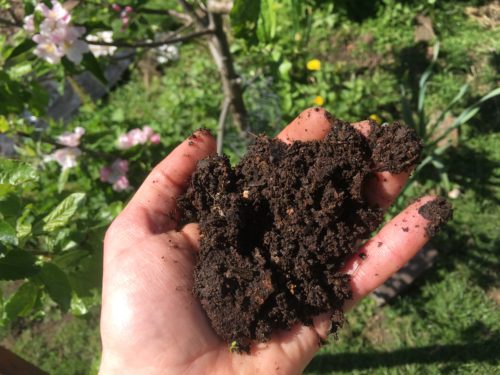
For several years I lived in a tent in woodland and I never really readjusted to this business of flushing poo away with clean drinking water. Besides, I have always liked to feel I am dealing with my own… stuff, both figuratively and literally. So when we moved into our current house a DIY compost toilet was first project on the list.
Initially I imagined installing an underfloor twin vault system with urine separation. Even going DIY, installing this system was going to be expensive, and either way would involve disruptive house alterations. Then I read The Humanure Handbook by Joseph Jenkins. Jenkins advocates a very simple low-cost system which requires no house alterations and takes up relatively little space. He also strongly, and convincingly, argues that the compost produced in a thermophilic (hot) compost heap is safe enough to use on your vegetable patch. Here’s how it works:
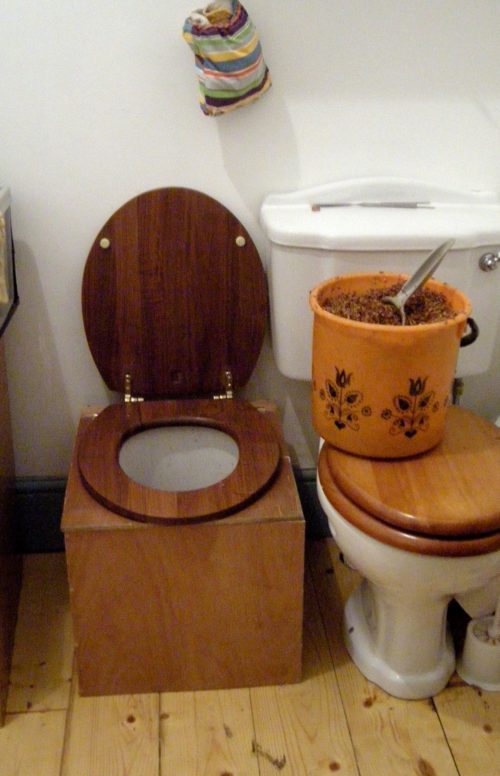
The toilet
A 20 litre bucket sits inside a plywood box with a toilet seat on it. Next to it is a bin filled with sawdust, ideally hardwood, this is your ‘soak’. The sawdust should be a little damp as this makes it more effective at filtering odours. Do your normal thing, no urine separation, add the sawdust and that’s it.
Believe it or not, it doesn’t smell, provided you add a good layer of damp sawdust. Once the bucket is full, replace the tight-fitting lid and add a new bucket. You need at least three identical buckets, so two can be full and one can be the current receptacle.
Here’s the catch: you need to empty the bucket. I realise for some people this is a pretty big catch, but it’s probably not as bad as you think. The bucket full of sawdust doesn’t smell bad and your well maintained composting heap doesn’t smell bad. You can quickly rinse the bucket using a hose with high pressure attachment and tip the water onto the heap. I then dry my bucket with a rag, which goes straight in the washing machine, then spray the bucket with vinegar. As a family of three we empty two buckets at a time once a week and it only takes 10 minutes.
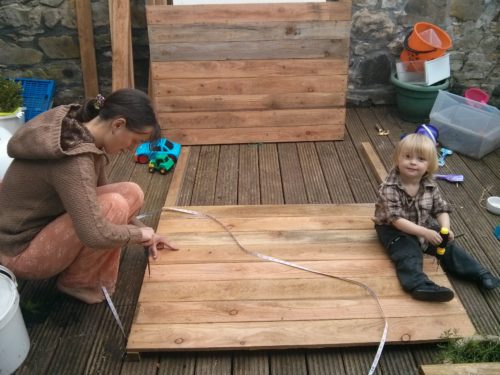
The heap
This is the important bit, your compost heap is the key to success. Jenkins recommends a container 1.6m2 and 1.3m high. I have found 1.1m2 is big enough, you should be able to go even smaller if you insulate your heap. You need at least two containers, one is resting while the other is filling up. Jenkins also recommends a third central bay, for storing soak and covering material. We don’t have that much space so we make do with two.
Once you have constructed your bins, place a thick bed of organic matter, such as straw or cardboard, in the bottom of your bin and begin to fill it. Keep the heap covered with a layer of straw or cardboard. Every time you add a bucket of waste make a hole in the middle of the heap with the fork (used only for that purpose), add the waste, pull the older waste back over and cover the heap with straw.

There are a number of things you do to keep your heap hot and healthy:
1. Flatten the top of your heap, think ‘cube’ rather than ‘pyramid’. The reduced surface area minimises heat loss, and the shape prevents fresh material from rolling down to the base of the heap, where it won’t become hot.
2. Bury new material in the centre of the heap where it is hottest and do not mix or turn the heap. The fresh material heats up quickly, then gradually cools as it becomes the lower layers. The cooler material at the base is maturing: becoming more stable and being colonised by a wide range of insects, worms, fungi and microorganisms. If we mix the heap we disturb this process and we cause the fresh material -the stuff we really want to heat up- to cool down.
3. Add both urine and faeces. In vault systems there are good arguments for separating urine but hot compost heaps are thirsty. Without the urine they will become too dry and the process will slow down. You also need the high nitrogen content of the urine to balance the carbon of the wood.
4. Cover the heap with straw or cardboard, this provides some insulation, prevents smells and can help soak up excess liquid, should your heap become too wet. Your heap should never smell: if it smells, add some cover material, if it still smells, add some more.
You can add all your kitchen and soft garden waste to the heap as well. After a year start a new heap, leaving the old one to mature for a year. Once the first heap has rested a year it will be beautiful compost, ready to add to your garden.
Soak and cover material
The ideal combination is damp hardwood sawdust for soak and straw for covering. The cover material is less critical, ideally it will be biodegradable, capable of absorbing excess moisture and able to let rain through, but its most important job is to block any smell. If I can’t get straw I use cardboard or dead leaves, if I am out of cardboard and leaves I might use weeds and grass clippings, or an old rug or black plastic as a last resort.
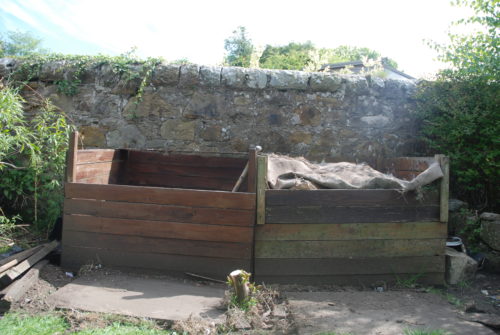
The ideal soak is damp hardwood sawdust. Soft wood sawdust will be slower to break down but in my experience still works ok. If you have a local sawmill or firewood supplier this is the place to ask. I have also used hardwood shavings from a wood-turner; they come in beautiful curls and spirals and are pleasant to handle. Unfortunately they do not block smells as well as the denser sawdust. They do cause the heap to heat up very quickly, as they are less dense and trap more air. In some cases you may be able to obtain only kiln dried sawdust, this will still work, but won’t be as effective at blocking smells. In this case, you can leave the sawdust out in the rain to at least get wet and, even better, begin to break down a little.

If you cannot obtain sawdust it may be worth experimenting with shredded paper, straw or leaf litter. These may not filter odours as effectively so an extra tight lid on the toilet may be required. In the case of paper or leaves, you may find it hard to maintain a hot heap, you could try insulating your container and finding ways to introduce more air into your heap.
James Chapman of Willowburn Lea uses spruce needles, of which there are a plentiful supply on his land, as both a soak and a cover material. These do work well and are effective at filtering smells, although, again, make it difficult to maintain a hot heap.
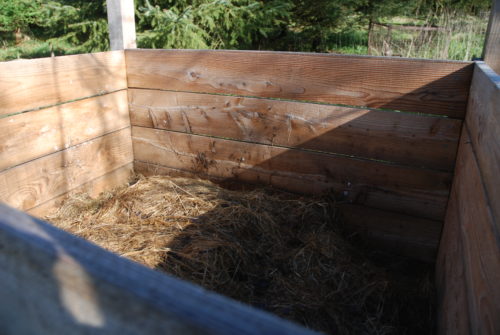
Health and hygiene
This is a huge topic and one I can only skim over here. If you are particularly interested, or particularly concerned, I suggest you read the Humanure Handbook, which is packed with data and references. The important points are:
- You are unlikely to become ill through handling your own fresh toilet waste; if it’s in there it came out of you, so you have it already! Most of us are pretty confident we can change a toddler’s nappy without dire health consequences and personally I find this a rather messier problem than emptying my toilet bucket.
- Heat kills bacteria and parasites. Many people who plan to use their compost for food growing use a thermometer to monitor the temperature of their heap to make sure it heats up sufficiently to destroy disease-causing organisms. Your heap doesn’t even need to be that hot, just hot enough, for long enough. See the graph below.
- But not just heat. We cannot guarantee that all parts of the waste are heated sufficiently to destroy all the bacteria and parasites, but it doesn’t need to be. The composting process, time, exposure to sunlight and competition with other microorganisms all take their toll.
- It works and soil isn’t sterile. The response to all of the above is often, ‘but how can you be sure it’s all gone?’ We are not looking for the compost to be sterile, just for it to have the same level of pathogens as your normal garden soil. Jenkins has been growing food in his garden using his humanure compost for over 30 years with no health problems. He has even had his own faeces tested on a couple of occasions to prove the point.
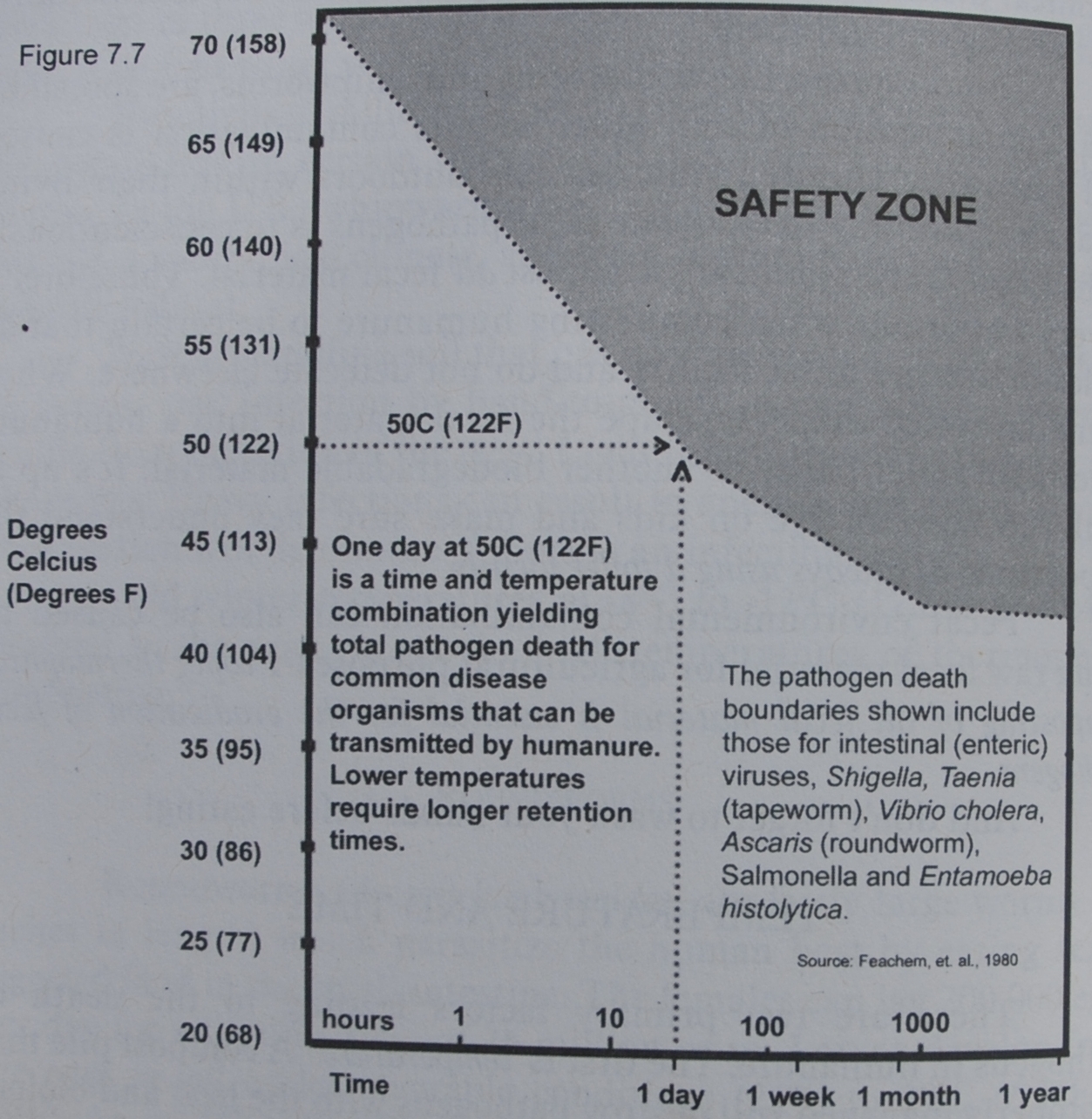
Most importantly you choose how to use the resulting compost. You may not be convinced by Jenkins’s argument, or perhaps your heap did not get hot enough, or you have a lot of visitors and are not comfortable using compost from the waste of the wider population. You might choose to leave your heap an extra year to mature, then you might use it only to mulch around your fruit trees, or even only around ornamental plants.
I don’t want to empty a bucket!
I realise this system isn’t for everyone. You have to love your compost toilet, if you hate the whole process it’s never going to be sustainable. The most tried and tested DIY alternative is the twin vault with urine separation. These systems usually involve a cool composting process, which may not as reliably destroy bacteria, but it is generally considered safe to use the resulting compost on fruit trees, for example. I recommend the book ‘Lifting the Lid’ by Harper and Halestrap if this is something you are interested in.
If a vault is not an option, you might want to explore the possibility of hot composting in insulated containers which can act both as a receptacle and composting vat, at least for the initial part of the process. I would love to hear from anyone who has experimented with this. There are also commercially available compact systems, which I believe are becoming more reliable. Again, please share your experience of these in the comments.
Whatever you choose to do I hope you gain the satisfaction of knowing you are dealing with your own…stuff.

Planning your own compost loo project? Our online course is for you! With over 3 hours of video led by experienced tutor Cordelia Rowlatt, plus an entire e-book on how to build, purchase, use and maintain a range of different compost toilets, it’s a snip at just £45 for lifetime access. Watch the trailer below and click here to buy.
If you’d like to learn more about compost loos, visit our dedicated topic introduction here. As well as our online course above, we also have our very own book – Compost toilets: a practical DIY guide – by Lowimpact.org’s Dave Darby, as well as Mandy Burton’s The Loveliest Loo colouring book.
The views expressed in our blog are those of the author and not necessarily lowimpact.org's
28 Comments
-
1mark holdforth May 27th, 2018
thank you lots of good info .i feel that i can do one myself now this been made clear what to do
thank mark
-
2singingsubversive May 27th, 2018
I’ve been advised that in Scotland SEPA is now trying to put people off doing this and is therefore telling people that they’ll get charged for dealing with their own ‘hazardous waste’. That said, I’ve discussed making a blackwater bed instead and they were pretty laid back about that.
-
3Lesley Anderson May 28th, 2018
It has been a while since I looked into this but, as I understand it, there is no legal issue with handling the ‘waste’ unless you are moving it off your own property (this would even apply to the resulting compost i.e. even in its decomposed state you can’t, in theory, transport it to your allotment without a lot of paperwork). There may be an issue with having to move the waste through your kitchen on the way to the garden. I think this would only be a problem if you have a business, like being a childminder. As far as composting waste goes there is little regulation surrounding systems that don’t use water, they are far less likely to cause pollution than other systems. Having said that, if you were building or renovating a property and applying for it to be the main way of dealing with the waste (i.e. you want permission not to have a septic tank or whatever) it’s probably a whole different ball game, though it can be done. If you are just setting it up alongside whatever system is already there, as long as you make sure you are not causing a ‘nuisance’ to your neighbours or pollution to water courses there is nothing they can do legally. Although as I said, its been a while since I looked into this so don’t take my word for it.
-
4Mike December 28th, 2018
Thankyou for this information, I’m making an off grid glamping site so this will very helpful
-
5Jera Igo August 23rd, 2019
Very helpful information. Now I’d like to know how to get permitted for a septic-free home off the sanitation grid in San Diego county!
-
6Mike Radcliffe January 24th, 2020
What are your thoughts on a mid stream collection for composting? I was thinking of creating a system where in the basement you have a 5 gal bucket that is plumbed into the system to strain out liquids right away to the grey collection system for reuse on toliets and irrigation, then solids remain and emptied once per day to the compost heap outside where like what you said it will compost and sit for a year? Thanks
-
7Dave Darby January 25th, 2020
Mike – see reply on topic intro – https://www.lowimpact.org/lowimpact-topic/compost-toilets/
-
8Jake February 2nd, 2020
Hi lesley – very helpful article! Do you put toilet paper in the heap also, if so or not, can you explain the science behind it? Thank you!
-
9Lesley Anderson February 2nd, 2020
Hi Jake, thank you! Yes toilet paper goes in the heap. Similar to the sawdust, it is a high carbon material which balances the high nitrogen in urine. The compost works fine without it though, so it is more that it is a compostable material and there is no reason not to add it.
-
10Shawn M Bernal February 26th, 2020
I wanted to share that I use America’s Choice Bedding Pellets for my “sawdust.” The pellets are very compact and take up a tremendous amount of moisture upon contact. The pellets have a nice wood smell to them and instantly remove any odors as they take up the moisture from the waste. Also very cheap, a 1 cubic foot bag is less than $6 at my local WalMart. It’s intended for horse stalls/animal bedding and works great for a composting toilet setup.
-
11Douglas Coulter (@wulliedouglas) March 2nd, 2020
Nice and simple to follow Lesley. Thanks for sharing. What did you use for the 20 litre buckets and where did you source them from?
Cheers!
-
12Tiy May 28th, 2020
Hi, composting toilet works brilliantly – no odours, however, because we are short of storage space we have made a compost heap inside a 105ltr drum, added the straw and veg waste as we go, I don’t think the waste is breaking down very quickly inside the drum. Could it be too small a space or maybe because our buckets are lined with compostable liner bags? oil drum full after approx. 10 buckets over 6 months. we will soon be using up 3- 4 buckets over 7 days for 2 people. so will not have room for many more drums at this rate, we do not have use of any land for desired compost heap. we really want to continue with the use of the toilet but need help perfecting disposal. Any ideas?
-
13Cordelia May 29th, 2020
Hi Tiy,
Great that you’re using this fantastic, simple system. It does strike me that 105 ltrs for toilet waste, veg waste and straw seems like a small volume for composting, so that may well be the issue. I have a few questions though: Are you adding worms to your heap? I think it’s a bit small to heat up reliably and worms will help to reduce the volume in a cool heap. Also, are you separating out the urine? I’m guessing probably yes, otherwise it would fill up even quicker. The compostable liner bags probably don’t help. I find they are slow to compost down relative to other waste and may act as a barrier for composting microorganisms and minibeasts.
As a general rule, the larger the heap, the longer it takes to fill and so the more time it has to break down while you are filling it. As a result it takes much more time to fill a large heap than several smaller ones. What area do you have available? Could you have fewer, larger containers to empty the buckets into? I’m also curious to know why/how you’re using up 3-4 buckets over 7 days for 2 people after 10 buckets over 6 months. What’s going on? – my imagination is working overtime ?
Cheers
Cordelia
-
14Tiy May 31st, 2020
Hi Cordelia
Many thanks for your reply. We are living on a barge permanently now but was only staying for weekends before. I saw on the internet that the humanure compost needs plenty of moisture and all their buckets contained all human waste and veggie waste they just chucked it all onto heap and covered in straw left for a year and was then good to use. I will get rid of bags and get some worms. We do use quite a bit of sawdust in the bucket as we thought it was good to keep urine soaked up, but that contributes to filling up. We Can probably get a couple of larger containers instead but has to be kept on top deck area. ? Thank you so much for any advice. Tiy
-
15Lesley Anderson May 31st, 2020
Hi @Tiy,
Yes, it is much harder to get hot heap with a small volume, this is probably your main issue. The other issue you might have are that you can’t structure the heap as described in this blog post (burying the new material in the middle). If you want to persevere with hot composting I would suggest trying insulated containers. You might want to do a bit of research to see if you can find anyone else who has made this work (I have not looked into it in recent years).
The fact your heap is not in contact with the soil could also be a factor; whatever sort of composting process you decide to go for, it might be an idea to ‘inoculate’ it with a small handful of material from a good compost heap, or at least good soil, so you get some beneficial microbes in there. In a fully contained heap it might also be trickier to manage the moisture levels, but it’s not something I have experience of. Sounds like you are managing that by altering how much sawdust you add. I think, in a fully contained heap like that, liners are the least of your worries (though they do not compost well in my experience, even in a hot heap).
I agree with Cordelia, looking into composting with worms (vermiculture, or vermiciompost), might be a good idea if hot composting is not going to work for you, people have made compact compost toilet systems using worms. If I get a chance later I will try and find some links for you. Do let us know what you decide to do and how you get on!
-
16Tiy June 1st, 2020
Hi Cordelia and Lesley, So pleased to get this advice, thank you so much. I have been looking at the heated type of container over the last few days so will investigate as soon as I can get to a local supplier/garden centre, although I did think that the drums were heating up a lot in the sun on deck but I didn’t actually explore inside the drum much… it’s more of a chuck’n’run type operation? My husband said it was a bit whiffy despite the actual bucket WC remaining odourless. We will carry out advised actions and take a more in depth look inside the drum to assess! I will definitely post again with the results. Thanks again. Brilliant useful info.
-
17Frank Abair August 11th, 2020
Used the most basic humanure toilet. Septic system DIED. Jenkins version, plywood box, toilet seat, 5 gallon bucket. Purchased sawdust. Used it two years. Had 3 55gallon steel drums with sealable lids. Dumped buckets, layered with leaves, when drum was full, sealed for a year. After more than a year, dumped drum. Nothing but friable low odor, particles. Just ran mower over it, snd it worked into the field like mulch. We have a new septic system now. The sawdust toilet worked very well, until we raised money for new septic
-
18Max August 28th, 2020
Hi. Great article – many thanks ? I want to employ this system in my house, but what I’m struggling with is what options there are to deal with grey water waste. We have a septic tank at the moment, but would the tank function if it only received grey water? Does it need the black water and poo to stay “healthy”. Are there any other options for dealing with grey water? There are two of us living in the house and we are very low water users. Many thanks
-
19Maggie April 22nd, 2021
Hello. Thank you for sharing your valuable information on compost toilets. I am interested in taking the online course, however I would like to know if your course deals with living in bear country. We live in British Columbia, Canada and have many bears, deer and other wildlife that come through our property regularly. In addition does your course cover the idea of using worms (vermicomposting) to break down excretions? Also we are considering a new home build in the future and would like to incorporate composting toilets into the house design. Would your course cover that? Thank you for your time.
-
20Dave Darby April 23rd, 2021
Maggie – yes, the course covers incorporating a compost loo into a house, and there is information on worms too. Not bears or wildlife though I’m afraid. What’s the issue with wildlife?
-
21Chelsea B June 5th, 2021
Hi Cordelia, Thanks for the info! We are testing it out and so far, so good! We are just wondering about rain … in the article, you mention that the cover should let rain through … we live in a very rainy area and so I am wondering if there is a threshold and if so, how to gauge/manage the amount of rain incorporated into the heap. We are using spruce boughs as the base insulation and to cover, dry mixed wood animal bedding wood shavings for the soak. Thanks in advance for the info!
-
22Andrea November 4th, 2021
I’m thinking about adding a composting system in my home, but am concerned about pharmaceuticals being left in the pile. Haven’t seen this addressed anywhere yet… Do you know if there’s been any research into humanure from people who are taking medications? Thanks for sharing your advice and experience!
-
23Dave Darby November 5th, 2021
Andrea – A study by the Department of Microbiology at the Agricultural School of Norway found that only a tiny percentage of antibiotics taken by a person will be excreted, and the dilution effect of the materials in the toilet will mean that the beneficial bacteria will hardly be affected at all.
Same goes for any medicines really – tiny amounts are excreted, and are just swamped by scale of the pile and all the microbial activity.
-
24Dave Darby November 5th, 2021
Andrea – PS sewage sludge is already used on farmland, but it’s straight from sewage works, from thousands of people on various medications, and without the waste being broken down by microbial activity first.
-
25Caron August 12th, 2022
I have recently read Joseph Jenkins Humanure Handbook 4th Edition & found your article really interesting as it answered some of my reservations e.g he specifically says not to cover the bin against rain but I thought it would get too wet (& hence anaerobic) in the typical UK climate.
I have no concerns with the loo bit, that’s quite straightforward; I’ve just installed a simple DIY compost toilet in our bathroom. I’m also fine with the composting side of things; I have composted all of our garden & kitchen waste for many years along with all our chicken & goose poo.
The big indecision that I have is regarding wee & whether to separate it or include it. Ideally I would like to include it as it’s far easier to deal with one bucket of muck than piss around (pardon the pun) with 2 separate buckets & disposal methods (it’s not possible to drain the pee direct to a soak away from our bathroom).
But, both my husband & I work from home & drink a lot of tea/coffee/beer so generate a lot of wee between us. I’m really worried that I’m going to end up with a smelly, anaerobic sludge with a lot of ‘run off’ rather than a good, hot, aerobic compost heap.
I would really appreciate your opinion & experience on this as most of what I’m reading seems to recommend keeping the wee separate & just adding the poo to a compost heap. It’s pickled my brain completely & now I don’t know which way to go.
Many thanks.
-
26Kirpi June 21st, 2023
No plywood box or toilet seat needed, just a bucket and a second bucket to hold the soak material.
When it is nearly full, tip it onto your compost heap.
But then I live alone and I don't give a stuff about what others think of my natural habits and they don't get invited toi eat my wonderful vegetables and fruits.
-
27Frank Abair June 21st, 2023
Money not available for two years to replace failed septic field and tank. Credit sucked. Unhappy family grudgingly participated in the simple composting toilet. I dumped and maintained. Earthy but no strong orders, everything in the bucket, cover.
Rotate three buckets. My property was fitted with steel 55 gallon barrels, with sealable lids, 3. layered with leaves, lid was always tight, when full, sealed and left for a year. When emptied, you couldn't see anything but wet sawdust, zero odor. Money showed up for new septic system. We are beck on septic system. Great to know that a plan B is easily set up, for less than 60 dollars.
-
28Frank Abair June 22nd, 2023
Grey water, I have a slope on 7 .48 acres. Grey water is every thing but toilet waste. Route ALL grey water to pipe exiting on a slope, that you own. It runs down hill, our property is wooded at the discharge site for grey water. You will need two or three times a year maintenance to keep water path clear
Night soil must be maintained in compost or sealed barrels with layering of leaves or sawdust. You will damage your well if you are not scrupulous in managing night soil. Not legal, for the most part, no worse than hosing off a driveway or hosing ogf livestock. We use grey water emptying to our slope to protect viability of our septic system. We used sawdust buckets for two years, then we went back on septic system, for toilet waste.




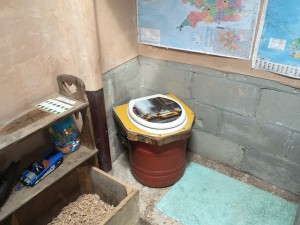 An example of Joe Jenkins’ ‘humanure’ composting toilet system, used successfully for 9 years
An example of Joe Jenkins’ ‘humanure’ composting toilet system, used successfully for 9 years
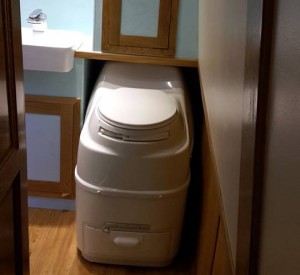 Can I have a compost loo instead of a chemical toilet in a camper van or a narrowboat?
Can I have a compost loo instead of a chemical toilet in a camper van or a narrowboat?
 Why flushing away ‘waste’ water is a bad idea, and what better options exist
Why flushing away ‘waste’ water is a bad idea, and what better options exist
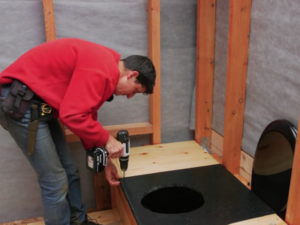 Our new compost toilets online course is live – and we think you’ll love it!
Our new compost toilets online course is live – and we think you’ll love it!
 Compost toilets
Compost toilets
 Composting
Composting
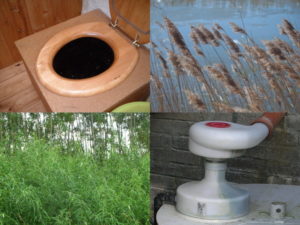 Low-impact sewage treatment
Low-impact sewage treatment
 Low-impact water supply
Low-impact water supply


